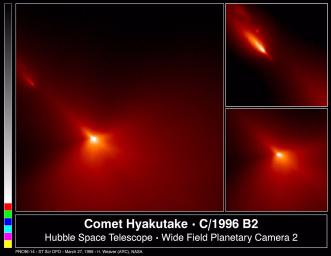
|
Hubble Probes Inner Region of Comet Hyakutake
- Click the image above for a larger view
- Full-Res JPEG (1152 x 893) (77.6 kB)
- Full-Res TIFF (1152 x 893) (1.3 MB)
Caption:
These are NASA Hubble Space Telescope images of comet Hyakutake (designated C/1996 B2), taken at 8:30 P.M., EST on Monday, March 25 when the comet passed at a distance of only 9.3 million miles from Earth.
Unlike most of the published images of Hyakutake, these Hubble images focus on a very small region near the heart of the comet, the icy, solid nucleus. The Hubble images provide an exceptionally clear view of the near-nucleus region of comet Hyakutake.
The images were taken through a red filter with the Wide Field Planetary Camera 2 (in WF mode). The sunward and tailward directions are at approximately the 4 o'clock and 11 o'clock positions, respectively. Celestial North and East are at approximately the 5:30 and 2:30 positions, respectively.
FULL-FIELD VIEW (Left) This image is 2070 miles across (3340 km) and shows that most of the dust is being produced on the sunward-facing hemisphere of the comet. Also at upper left are three small pieces which have broken off the comet and are forming there own tails.
Icy regions on the nucleus are activated as they rotate into sunlight, ejecting large amounts of dust in the jets that are faintly visible in this image. Sunlight striking this dust eventually turns it around and "blows" it into the tailward hemisphere. What might be another jet is emanating from the nightside of the nucleus, but this direction might be misleading due to the angle of the jet relative to our line-of-site.
CLOSE-UP OF NUCLEUS (Bottom Right) This expanded view of the near-nucleus region is only 470 miles (760 km) across. The nucleus is near the center of the frame, but the brightest area is probably the tip of the strongest dust jet rather than the nucleus itself. Presumably, the nucleus surface lies just below this bright jet. Further analysis may allow scientists to disentangle the nucleus from its atmosphere (coma), presently its difficult to estimate the nucleus' size.
CLOSE-UP OF COMET FRAGMENTS (Top Right) This image shows pieces of the nucleus that apparently broke off and were first detected during ground-based observations on March 24. The Hubble image shows at least three separate objects that are probably made up of coarse-grained dust. Large fragments of the nucleus would not be accelerated into the tail, which appears to be the case in this image.
Background Info:
The Wide Field/Planetary Camera 2 was developed by the Jet Propulsion Laboratory and managed by the Goddard Space Flight Center for NASA's Office of Space Science.
This image and other images and data received from the Hubble Space Telescope are posted on the World Wide Web on the Space Telescope Science Institute home page at URL http://oposite.stsci.edu/ .
Cataloging Keywords:
| Name | Value | Additional Values |
|---|---|---|
| Target | C/1996 B2 (Hyakutake) | |
| System | ||
| Target Type | Comet | |
| Mission | Hubble Space Telescope (HST) | |
| Instrument Host | Hubble Space Telescope | |
| Host Type | Space Telescope | |
| Instrument | Wide Field/Planetary Camera 2 (WFPC2) | |
| Detector | ||
| Extra Keywords | Atmosphere, Color, Dust, Infrared, Rotation, Visual | |
| Acquisition Date | ||
| Release Date | 1998-08-03 | |
| Date in Caption | ||
| Image Credit | NASA/JPL/STScI | |
| Source | photojournal.jpl.nasa.gov/catalog/PIA01290 | |
| Identifier | PIA01290 | |
